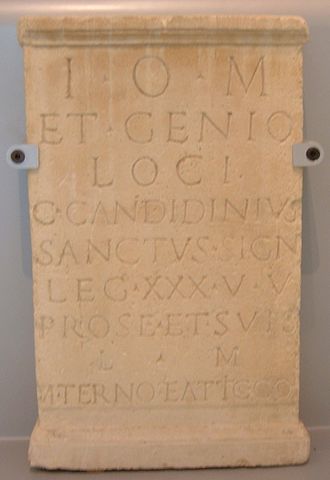Genius loci
| Advanced search |
- About 3 results found and you can help!
 Votive inscription to Jupiter Optimus Maximus and the Genius loci by the Signifer of Legio XXX Ulpia Victrix on behalf himself and his own (legion) during the consulate of Maternus and Atticus (185 AD). |
In classical Roman religion a genius loci was the protective spirit of a place. It was often depicted in religious iconography as a figure holding a Cornucopia, patera and/or a snake. There are many Roman altars found in Western Europe dedicated in whole or in part to the particular Genius Loci. The Roman imperial cults of the Emperor and the imperial house are in part derived from the Genius Loci. Professor Greg Woolf, in his article Divinity and Power in Ancient Rome states that "Regular sacrifices were also paid to the genius of the reigning emperor by local neighborhood associations". These 265 local districts had their cult organised around the Lares Compitales (deities of the crossroads) but the Emperor Augustus "reorganized the cult into a worship of the Lares Augusti along with the Genius Augusti". The idea, approximately, being the Emperor's genius is the genius loci of the entirety of the "place" of the Roman empire.
- See also: Wikipedia
- Related: Add a related term
| Essay on the Genius loci in landscape and garden d... Essay on the Genius loci in landscape and garden design www.gardenvisit.com/landscape/architecture/14.1-genius-loci.htm - Web |
| St. Giles, Tockenham, Wiltshire St. Giles, Tockenham, Wiltshire www.oodwooc.co.uk/ph_tockenham.htm - Web |
| Relief in the wall Relief in the wall www.tockenham.org.uk/page17.html - Web |
Average relevance